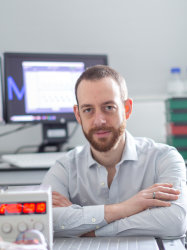Microhaemodynamics
In diseases such as diabetes and malaria, complications that cause the main damage to the patient are predominantly related to microvascular dysfunction.
The microvasculature comprises the smallest blood vessels in the body (arterioles, capillaries and venules). The capillaries are the site of oxygen and nutrient exchange, and they need a tightly regulated pressure and control of exchange across the vessel wall. This regulation depends on local mechanical forces caused by the flowing blood. Failure of microvascular flow leads to sequalae such as neuropath and retinopathy.
To better understand these phenomena, and hence to develop new approaches to treatment, it is critical to first understand the mechanics of blood flow in microvessels.
Blood flow in microvessels is determined by the red blood cells, which make up 10-40% of the volume of the blood. Our research focuses on the fluid dynamics of microvascular blood flow, and in particular spatial distributions of red blood cells within and between vessels. We combine experimental and numerical fluid dynamics measurements with microfluidics and organ-on-chip technology to uncover the critical factors involved in microscale blood flow. This allows us to develop new numerical methods and investigate the effects of changes to red blood cells that are observed in microvascular disease.
JAMVENT Ventilator

At the beginning of the pandemic, the vBS lab took the lead on a project to produce a new approach to ventilation that did not interfere with supply chains of existing ventilators. We achieved this using on-off solenoid valves, which are cheaper, easier to source and maintain than the proportional solenoid valves used in typical ICU ventilators.
The design achieves performance criteria, is robust and low cost. It is therefore perfectly suited to Low and Middle Income Countries and Newly Emerging Economies where there was a severe shortage in ventilators prior to the pandemic, which was only exacerbated by COVID-19.
Please see www.JAMVENT.com for further details
OCULAR BIOMECHANICS

Glaucoma is a world leading cause of blindness, for which elevated intraocular pressure (IOP) is the major risk factor. Reduction of IOP is the sole target for treating glaucoma patients, but existing approaches fail to benefit a large number of patients.
Intraocular pressure is regulated by the flow of aqueous humour, secreted from the blood, across the resistance of the trabecular meshwork and Schlemm’s canal, a vessel that encircles the front of the eye. Improved understanding of the mechanobiology of this tissue and the physiology of aqueous humour outflow from the eye is necessary to develop improved treatments for glaucoma.
Murine eyes are anatomically similar to humans and hence make ideal models for studying ocular biomechanics. However, their diminutive size means that the flow rates are of the order of 50 nl/min, a flow rate so low that it would take two weeks to fill a single millilitre. Such measurements require extreme precision in both control and measurement.
We developed the iPerfusion platform, which enables accurate, repeatable measurements of aqueous humour flows and is the world leading technology for these measurements. iPerfusion has also been used to measure brain tissue permeability and lymph node flow resistance.

